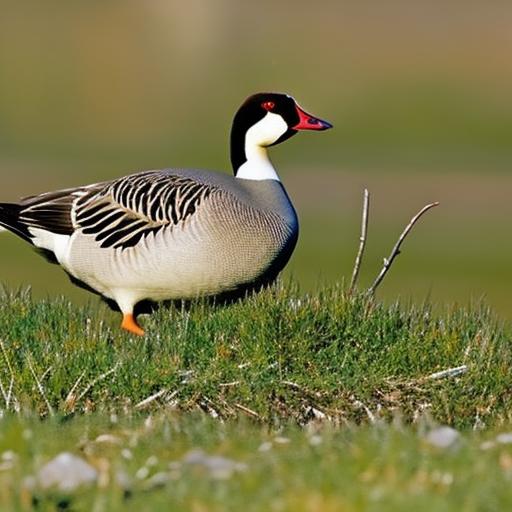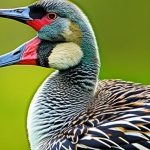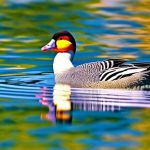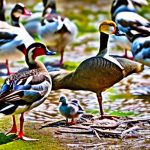Geese infestation is a common problem in many areas, especially those near bodies of water. While these birds may seem harmless, they can cause significant damage to property and pose health risks to humans. Finding humane solutions to deter geese is crucial in order to protect both the environment and the well-being of these animals.
Key Takeaways
- Canadian geese are attracted to open spaces near water and grassy areas.
- Physical barriers such as fences and netting can be effective in deterring geese.
- Visual deterrents like decoys and reflective tape can also discourage geese from settling.
- Sound-based repellents like propane cannons and ultrasonic devices can be used to scare geese away.
- Landscaping strategies like planting tall grasses and using hedges can make areas less attractive to geese.
Understanding the Behavior of Canadian Geese
Canadian geese are known for their distinctive appearance and honking sound. They are large birds, typically weighing between 5 and 14 pounds, with a wingspan of up to 6 feet. These birds are attracted to areas with open water, grassy fields, and ample food sources.
Geese are social animals and tend to gather in large flocks. They are also highly territorial and will defend their nesting sites aggressively. This territorial behavior is one of the reasons why geese are attracted to certain areas, as they seek out locations that provide suitable nesting sites and ample food.
Implementing Physical Barriers to Deter Geese
One effective method of deterring geese is by implementing physical barriers. There are several types of physical barriers that can be used, including fences, netting, and floating barriers.
Fences can be used to create a physical barrier between geese and the area you want to protect. However, it is important to ensure that the fence is tall enough (at least 3 feet) and has no gaps or openings that geese can squeeze through.
Netting can be used to cover areas such as ponds or gardens, preventing geese from accessing these areas. It is important to ensure that the netting is securely fastened and does not have any gaps where geese can enter.
Floating barriers can be used in bodies of water to prevent geese from landing or swimming in certain areas. These barriers create an obstacle for the geese, making it difficult for them to access the area.
While physical barriers can be effective in deterring geese, they may not be suitable for all situations. For example, they may not be practical for large areas or areas with complex terrain. Additionally, some physical barriers may alter the aesthetics of the property.
Using Visual Deterrents to Keep Geese Away
Visual deterrents can also be effective in deterring geese. These deterrents make use of visual stimuli that geese find threatening or intimidating.
Examples of visual deterrents include scarecrows, reflective tape, and predator decoys. Scarecrows can be placed in areas where geese are likely to gather, such as gardens or open fields. Reflective tape can be hung from trees or poles to create a visual disturbance that scares geese away. Predator decoys, such as plastic owls or coyotes, can also be effective in deterring geese.
When using visual deterrents, it is important to move them around regularly to prevent geese from becoming accustomed to them. It is also important to ensure that the deterrents are visible and placed strategically in areas where geese are likely to gather.
Employing Sound-based Repellents
Sound-based repellents can be used to deter geese by creating loud noises or sounds that are unpleasant to them. These repellents can be effective in scaring geese away from an area.
Examples of sound-based repellents include propane cannons, ultrasonic devices, and recorded distress calls. Propane cannons create loud noises at regular intervals, which startle and scare geese away. Ultrasonic devices emit high-frequency sounds that are unpleasant to geese but not audible to humans. Recorded distress calls mimic the sounds made by distressed geese, which can deter other geese from entering the area.
When using sound-based repellents, it is important to consider the noise levels and any potential impact on nearby residents or wildlife. It is also important to vary the timing and frequency of the sounds to prevent geese from becoming accustomed to them.
Landscaping Strategies to Discourage Geese
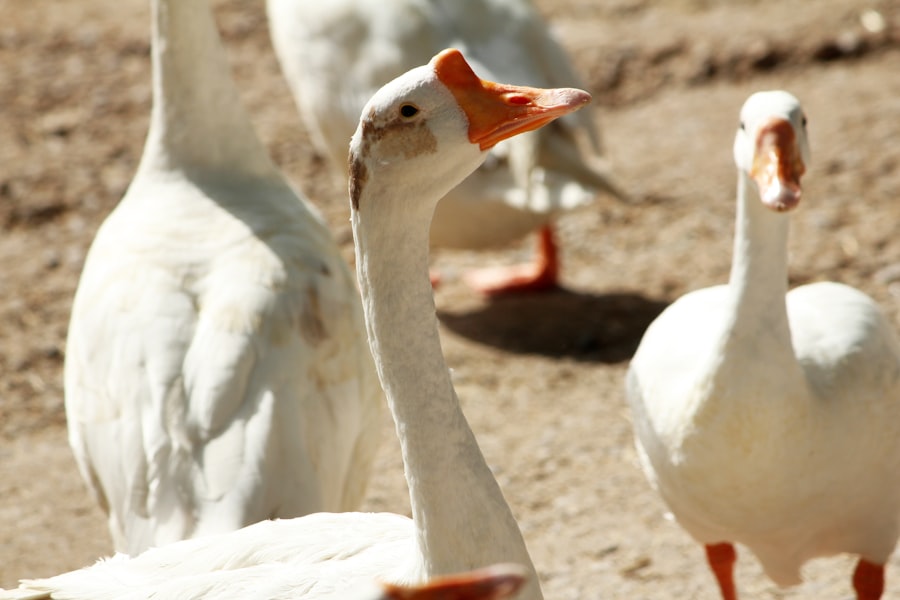
Landscaping strategies can be used to discourage geese from gathering in certain areas. These strategies involve modifying the landscape to make it less attractive or suitable for geese.
Examples of landscaping strategies include planting tall grasses or shrubs, installing rocks or gravel in open areas, and creating slopes or barriers around bodies of water. Tall grasses and shrubs provide cover and make it difficult for geese to access open areas. Rocks or gravel can be used to create an uncomfortable surface for geese to walk on. Slopes or barriers around bodies of water can make it difficult for geese to access the water.
When using landscaping strategies, it is important to consider the maintenance requirements and the impact on the overall aesthetics of the property. It is also important to regularly monitor and maintain the landscaping features to ensure their effectiveness.
Removing Food Sources to Prevent Geese from Linger
One effective way to deter geese is by removing their food sources. Geese are attracted to areas with ample food, so by removing these food sources, you can discourage them from lingering in the area.
Common food sources for geese include grass, grains, and aquatic plants. To remove these food sources, you can mow the grass regularly, remove fallen fruits or seeds, and use herbicides or other methods to control aquatic plants.
It is important to note that removing food sources alone may not be sufficient in deterring geese, as they may still be attracted to other factors such as open water or suitable nesting sites. Therefore, it is recommended to combine this method with other deterrents for maximum effectiveness.
Creating Safe Zones for Geese to Encourage Them to Move On
Creating safe zones for geese can be an effective way to encourage them to move on. Safe zones provide geese with a suitable habitat where they can rest, feed, and nest without causing damage or posing risks to humans.
To create safe zones, you can designate specific areas where geese are allowed to gather and provide suitable habitat features such as open water, grassy areas, and nesting sites. These safe zones should be located away from areas where geese are not desired, such as gardens or recreational areas.
Creating safe zones can help to reduce conflicts between geese and humans, as well as minimize damage to property. It is important to regularly monitor and maintain these safe zones to ensure their effectiveness.
Utilizing Motion-activated Devices to Scare Geese
Motion-activated devices can be used to scare geese away by creating sudden movements or noises that startle them. These devices are triggered by the presence of geese and can be effective in deterring them from an area.
Examples of motion-activated devices include sprinklers, lights, and air cannons. Sprinklers can be set up in areas where geese are likely to gather and activated when geese approach. Lights can be installed near bodies of water or open areas and turned on when geese are present. Air cannons create loud noises or blasts of air that scare geese away.
When using motion-activated devices, it is important to consider the timing and frequency of the activations to prevent geese from becoming accustomed to them. It is also important to ensure that the devices are placed strategically in areas where geese are likely to gather.
Seeking Professional Help for Geese Control
In some cases, it may be necessary to seek professional help for geese control. Professional geese control services have the expertise and resources to effectively manage geese infestations and implement humane deterrent methods.
When deciding whether to seek professional help, it is important to consider the severity of the infestation, the potential risks or damage caused by geese, and the effectiveness of the methods you have tried. Professional geese control services can assess the situation, develop a customized plan, and implement effective deterrent methods.
When choosing a professional geese control service, it is important to consider their experience, reputation, and the methods they use. It is also important to ensure that they comply with local regulations and guidelines for humane wildlife management.
Tips for Maintaining a Geese-free Property
Once you have successfully deterred geese from your property, it is important to maintain a geese-free environment to prevent them from returning. Regular maintenance and monitoring are key to ensuring that geese do not become a problem again.
Some tips for maintaining a geese-free property include:
– Regularly inspecting the property for signs of geese or nesting activity
– Removing any potential food sources or attractants
– Implementing deterrent methods on an ongoing basis
– Monitoring and adjusting deterrent methods as needed
– Consulting with professionals if any issues arise
By following these tips, you can help to ensure that your property remains free from geese and minimize the risk of future infestations.
In conclusion, finding humane solutions to deter geese is crucial in order to protect both the environment and the well-being of these animals. Understanding the behavior of Canadian geese and implementing various deterrent methods can help to effectively manage geese infestations.
Physical barriers, visual deterrents, sound-based repellents, landscaping strategies, removing food sources, creating safe zones, utilizing motion-activated devices, seeking professional help, and maintaining a geese-free property are all effective methods that can be used in combination to deter geese.
By implementing these methods and regularly maintaining your property, you can create a safe and geese-free environment while respecting the well-being of these animals.
If you’re looking for effective ways to keep Canadian geese off your property, you may also be interested in learning about the best location to place your chicken coop. Poultry Wizard offers a helpful article on where to put your chicken coop, which can provide valuable insights on creating a secure and predator-free environment for your chickens. By implementing strategies mentioned in this article, such as proper fencing and positioning, you can not only protect your chickens but also deter unwanted visitors like Canadian geese. Check out the article here for more information.
FAQs
What are Canadian geese?
Canadian geese are large water birds that are native to North America. They are known for their distinctive black heads and necks, white cheeks, and brown bodies.
Why do Canadian geese come onto my property?
Canadian geese are attracted to properties that have open water, grassy areas, and food sources. They may also be attracted to properties that provide shelter from predators.
Are Canadian geese dangerous?
Canadian geese are generally not dangerous to humans, but they can become aggressive if they feel threatened or if they are protecting their young. They may also carry diseases that can be transmitted to humans.
How can I keep Canadian geese off my property?
There are several methods that can be used to keep Canadian geese off your property, including installing fencing or netting, using scare tactics such as loud noises or visual deterrents, and removing food sources.
Is it legal to harm Canadian geese?
Canadian geese are protected under the Migratory Bird Treaty Act, which makes it illegal to harm or kill them without a permit. It is important to use humane methods to deter geese from your property.
What should I do if I have a problem with Canadian geese?
If you have a problem with Canadian geese on your property, you can contact a wildlife control professional or your local animal control agency for assistance. They can provide advice on humane methods for deterring geese and may be able to help remove them from your property.
Meet Walter, the feathered-friend fanatic of Florida! Nestled in the sunshine state, Walter struts through life with his feathered companions, clucking his way to happiness. With a coop that’s fancier than a five-star hotel, he’s the Don Juan of the chicken world. When he’s not teaching his hens to do the cha-cha, you’ll find him in a heated debate with his prized rooster, Sir Clucks-a-Lot. Walter’s poultry passion is no yolk; he’s the sunny-side-up guy you never knew you needed in your flock of friends!

